About O&M for Students with Deafblindness
Orientation & Mobility (O&M) is taught to students with deafblindness to enable them to interact and navigate their environment safely, efficiently and as independently as possible. The skills and knowledge that O&M instruction provides has a lifelong impact because they provide students with the tools needed for autonomy, decision making, and participation in society.
The following menus aim to share information about O&M to help school teams understand the importance of including O&M instruction in the educational programs for all students with deafblindness.
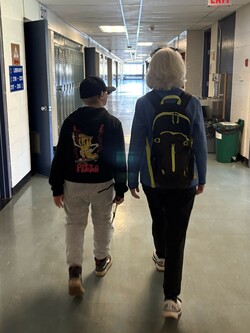
Qualified and Certified O&M Specialists are specially trained to provide instruction in orientation and mobility to individuals who are visually impaired, blind, and deafblind. With their knowledge and experience, O&M specialists teach students to understand where they are and where they would like to go (orientation) and how to get there safely and as independently as possible (mobility). O&M specialists also provide instruction in spatial awareness, sensory efficiency, body and environmental concepts which are also essential components of a good educational program. O&M skills are essential for students to be successful and fully participate in life (ACVREP, n.d.).
O&M specialists have completed a graduate educational program which includes a 350+ hour internship under supervision (ACVREP, n.d.).
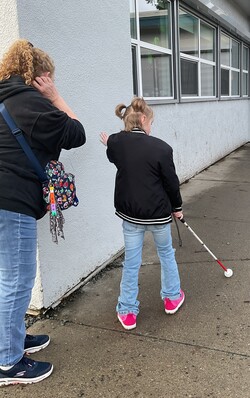
Through individualized, direct instruction from an O&M specialist, students with deafblindness learn the skills needed to travel throughout the environment safely, efficiently, and as independently as possible. The scope of O&M encompasses the following teaching areas (ACVREP, n.d.):
- Concept Development
- Sensory awareness and perceptual development
- Orientation
- Mobility systems and techniques
- Blind and vision assisted travel skills
- Street crossing
- Assistive and access technology
- Environmental access
- Self-determination
To read more about the scope of practice, visit the website for the Academy for Certification of Vision Rehabilitation & Education Professionals (ACVREP). Link below.

O&M specialists assess, teach, implement, and evaluate programs related to O&M for their students. The role of EA-Intervenors in supporting O&M instruction is by working under the direction of the O&M specialist. EA-Intervenors may be provided instruction on how to support concept development and specific O&M techniques and so that their student receives regular practice with skills in their school environments (Fazzi, Naimy, & Casias, 2024).
O&M specialists find EA-Intervenors to be valuable members of the team because they know the student well. EA-Intervenors work with the student’s team to facilitate communication, independent living skills, and movement (Sauerburger, Lolli, & Bourquin, 2024). Along with the Teacher for Students with Visual Impairments and Teacher for the Deaf and Hard of Hearing, the EA-Intervenor can provide information about the student’s visual and hearing, communication, and learning needs (Sauerburger, Lolli, & Bourquin, 2024).
If a student uses alternate communication systems and devices, the EA-Intervenor may need to teach the O&M specialist how to communicate with your student. If a student uses ASL, haptics, and/or tactile signing, the EA-Intervenor may need to provide interpretation (Sauerburger, Lolli, & Bourquin, 2024).
POPDB offers an advanced course for Educational Assistants training to become Intervenors. IIDC 330 Key Issues Around Supporting Orientation and Mobility is a hybrid course consisting of online instruction and an in-person component. The course looks at issues in O&M as related to students with deafblindness and participants learn the purpose and role of O&M in the life of students who are deafblind. Details can be found on the POPDB website link below.
IIDC 330 Key Issues Around Supporting O&M
For a comprehensive breakdown of O&M Delivery Guidelines, please check out the link below to a document created by APSEA (Atlantic Provinces Special Education Association).
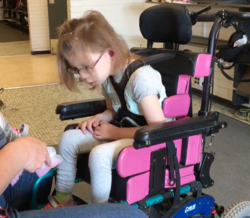
O&M for students who are deafblind and use wheelchairs is important, so students engage with their environment. It helps increase independence and facilitates a deeper understanding of the world around them (Bozeman &. McCulley, 2024)
Spatial awareness, sensory awareness, environmental concepts, directions, laterality, mapping, landmarks, information cues, time-distance awareness, and self-determination are just a few of the critical content areas that are equally important to students who are in wheelchairs as those who ambulate (Bozeman & McCulley, 2024).
O&M specialists have helpful instructional strategies to help teach students with deafblindness in wheelchairs how to navigate independently, including the use of manual and propulsion wheelchairs, forward and backward travel, making turns, navigating narrow spaces, operating doors, negotiating curb ramps and street crossings, and public transit (Crawford, 2016; Crawford 2014).
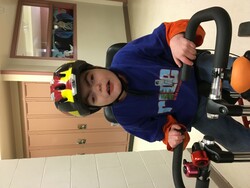
Learning to walk is a developmental skill and when an individual is blind or has reduced vision, a greater amount of effort is required to ensure balance, postural awareness, and personal safety (Rosen & Riddering, 2024). It is essential that young children get moving to develop their muscle tone, proprioception, and coordination (Rosen & Riddering, 2024). Students may need encouragement to get moving in their environment and an adaptive mobility device (AMD) may help facilitate movement and the willingness to move around (Sapp & Anthony, 2024).
The O&M specialist, along with physiotherapist (PT) and occupational therapist (OT) are key team members to help get students with deafblindness moving and learning to navigate at the same time. Be sure to involve your O&M specialist when adaptive equipment such as bikes, walkers, and propulsion wheelchairs are going to be part of the program.
Students with deafblindness and complex profiles have an important need for O&M instruction. According to Ambrose-Zacken & Anderson (2024), O&M instruction can help increase a student’s movement and participation in their day. Safe travel, as independent as possible travel, and autonomy in travel increases the student’s life choices in the present and, in the future, (Ambrose-Zacken & Anderson, 2024).
O&M specialists are specially trained to teach spatial awareness, sensory awareness, environmental concepts, directions, laterality, safe navigation, and self-determination. These are a few of the important content areas for the educational programs of students with deafblindness and complex profiles. O&M specialists also have helpful instructional strategies that will support individuals with a wide variety of cognitive and developmental challenges to travel safely, efficiently, and as independently as possible.
Adaptive Mobility Device (AMD): a mobility aid that encourages and supports people to move through the environment. AMDs offer information about the terrain on their path (Weiner, Wall Emerson, & Blasch, 2024)
Body Concepts / Body Image: knowing and understanding the parts of the body – what they are, what they do, how they move, and how they relate to other body parts (Fazzi & Barlow, 2017)
Clue: information that an individual pairs with other information to help identify one’s orientation or the location of objects, people, or places around you (Fazzi & Barlow, 2017).
Disorientation: confusion / not knowing where you are in the environment (Fazzi & Barlow, 2017)
Echolocation: using reflected sound to help interpret the environment such as the presence of openings (hallways, doorways), walls, and other objects (Fazzi & Barlow, 2017)
Egocentric Frame of Reference: understanding the position and location of objects or places as related to your body in the environment (Weiner, Wall Emerson, & Blasch, 2024)
Environmental Features: detectable traits found in the environment including size, shape, colour, and texture. Environmental features can also be items found in the environment such as sign posts, telephone poles, sidewalks, streets, stores, etc. (Fazzi & Barlow, 2017).
Guide Technique: procedure for assisting a person with a visual impairment for safe and efficient travel (Fazzi & Barlow, 2017). Individuals who provide guidance are called human guides.
Label: phrase or name given to a place or object for identification purposes (Fazzi & Barlow, 2017)
Landmark: a permanent or constant feature (object, sound, odour, temperature, visual clue) that one consistently finds in the environment during travel that helps identify a particular location (Weiner, Wall Emerson, & Blasch, 2024).
Laterality: awareness and recognition of the right and left sides of the body (Weiner, Wall Emerson, & Glasch, 2024)
Long cane: a mobility aid used by people with visual impairments that provides information about the environment through probing the cane tip and the haptic feedback conducted through the cane to the user (Fazzi & Barlow, 2017)
Mobility: process of moving from your current location to your destination safely, effectively, and as independently as you are able to (Weiner, Wall Emerson, & Blasch, 2024)
Object-to-Object Spatial Relationships / Allocentric Frame of Reference: understanding the relationship between objects or places independent of your position in space (Fazzi & Barlow, 2017)
Orientation: using information that you have gathered through your senses to know where you are presently and where you would like to go. It also involves knowing how you will get to y our destination (Weiner, Wall Emerson, & Blasch, 2024).
Orientation & Mobility (O&M): the field of instruction around teaching the skills, knowledge, and techniques required to an individual how to orient themselves and move as independently as possible through the environment (Weiner, Wall Emerson, & Blasch, 2024)
Orientation & Mobility Specialist: an individual who is specially trained to teach O&M to individuals who are visually impaired, blind, and deafblind (ACVREP, n.d.). The O&M Specialist is qualified to teach human guide, the use of the long cane, street crossing and intersection analysis, use of electronic travel aids, and dog guides (Weiner, Wall Emerson, & Blash, 2024)
Spatial Concepts: understanding the relationship between objects and people relative to one another (Weiner, Wall Emerson, & Blasch, 2024)
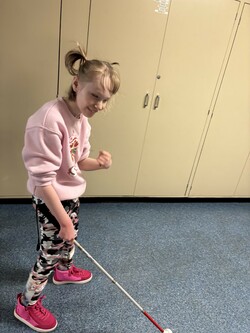
ACVREP. (n.d.). The scope of practice. https://www.acvrep.org/certifications/coms
Ambrose-Zacken, G., & Anderson, D. (2024). Teaching orientation and mobility to learners who are blind or visually impaired and have cognitive impairments. In W. R. Wiener, R. S., W. S. Wall Emerson, & B. B. Blasch (Eds.), Foundations of orientation and mobility: Instructional strategies and practical applications, (4th ed., Vol 2). APH Press.
BC Ministry of Education and Child Care. (2024). Inclusive education services: A manual of policies, procedures and guidelines. https://www2.gov.bc.ca/assets/gov/education/administration/kindergarten-to-grade-12/inclusive/inclusive_ed_policy_manual.pdf
Bozeman, L., & McCulley, R. (2024). Improving orientation for learners who are blind or have low vision. In W. R. Wiener, R. S., W. S. Wall Emerson, & B. B. Blasch (Eds.), Foundations of orientation and mobility: Instructional strategies and practical applications, (4th ed., Vol 2). APH Press.
Crawford, J.S. (2016). Orientation and mobility tools and techniques. In N. Griffin-Shirley & L. Bozeman (Eds.), O&M for independent living: Strategies for teaching orientation and mobility to older adults (pp. 79-140). AFB Press.
Crawford, J.S. (2014). Wheelchair orientation and mobility. Perkins School for the Blind. https://www.perkins.org/resource/wheelchair-orientation-mobility/
Fazzi, D.L., & Barlow, J.M. (2017). Orientation and mobility techniques: A guide for the practitioner (2nd ed.). AFB Press.
Fazzi, D.L., Naimy, B.J., & Casias, N. Teaching orientation and mobility to school-age children. In W. R. Wiener, R. S., W. S. Wall Emerson, & B. B. Blasch (Eds.), Foundations of orientation and mobility: Instructional strategies and practical applications, (4th ed., Vol 2). APH Press.
Lewis, S. & Allman, C. B., (2014). Learning, development, and children with visual impairments: The evolution of skills. In C. B. Allman & S. Lewis (Eds.), ECC essentials: Teaching the expanded core curriculum to students with visual impairments (pp. 3-14). AFB Press.
McCarthy, T. (2025, January 28). O&M for students with more complex profiles. PRCVI Presentation, Canada. https://www.youtube.com/watch?v=LGDKzaHBhOY
Rosen, S. & Riddering, A.T. (2024) Sensorimotor facilitation in orientation and mobility. In W. R. Wiener, R. S., W. S. Wall Emerson, & B. B. Blasch (Eds.), Foundations of orientation and mobility: Instructional strategies and practical applications, (4th ed., Vol 2). APH Press.
Sapp, W.K. & Anthony, T.L. (2024). Orientation and mobility services in the early childhood years. In W. R. Wiener, R. S., W. S. Wall Emerson, & B. B. Blasch (Eds.), Foundations of orientation and mobility: Instructional strategies and practical applications, (4th ed., Vol 2). APH Press.
Sauerburger, D., Lolli, D., & Bourquin, E.A. (2024). Teaching orientation and mobility to learners with vision and hearing loss. In W. R. Wiener, R. S., W. S. Wall Emerson, & B. B. Blasch (Eds.), Foundations of orientation and mobility: Instructional strategies and practical applications, (4th ed., Vol 2). APH Press.
Wiener, W. R., Wall Emerson, R. S., & Blasch, B. B. (2024). Glossary. In W. R. Wiener, R. S., W. S. Wall Emerson, & B. B. Blasch (Eds.), Foundations of orientation and mobility: History and theory, (4th ed., Vol 1). APH Press.
Wiener, W. R., Wall Emerson, R. S., & Blasch, B. B. (2024). Glossary. In W. R. Wiener, R. S., W. S. Wall Emerson, & B. B. Blasch (Eds.), Foundations of orientation and mobility: History and theory, (4th ed., Vol 2). APH Press.
Information Printable
If you require a hard copy of the above information, please click on the link below.